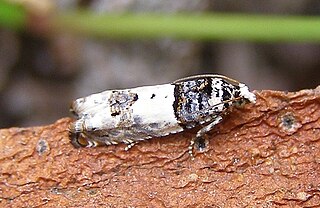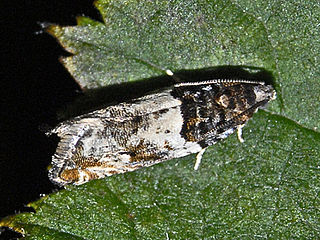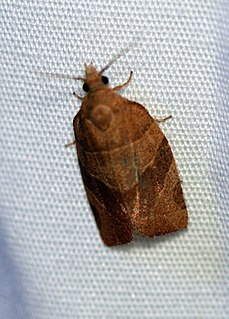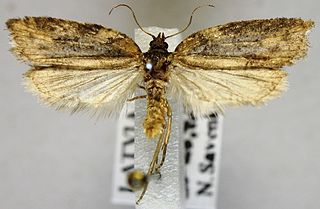| Archips mortuanus | |
|---|---|
| Scientific classification | |
| Kingdom: | Animalia |
| Clade: | Euarthropoda |
| Class: | Insecta |
| Order: | Lepidoptera |
| Family: | Tortricidae |
| Genus: | Archips |
| Species: | A. mortuanus |
| Binomial name | |
| Archips mortuanus (Kearfott, 1907) [1] | |
| Synonyms | |
| |
Archips mortuanus, the dusky-back leaf roller, is a species of moth of the family Tortricidae. It is found in eastern North America, where it has been recorded from Maine, Michigan and New York. [2]

Moths comprise a group of insects related to butterflies, belonging to the order Lepidoptera. Most lepidopterans are moths, and there are thought to be approximately 160,000 species of moth, many of which have yet to be described. Most species of moth are nocturnal, but there are also crepuscular and diurnal species.

The Tortricidae are a family of moths, commonly known as tortrix moths or leafroller moths, in the order Lepidoptera. This large family has over 10,350 species described, and is the sole member of the superfamily Tortricoidea, although the genus Heliocosma is sometimes placed within this superfamily. Many of these are economically important pests. Olethreutidae is a junior synonym. The typical resting posture is with the wings folded back, producing a rather rounded profile.

North America is a continent entirely within the Northern Hemisphere and almost all within the Western Hemisphere; it is also considered by some to be a northern subcontinent of the Americas. It is bordered to the north by the Arctic Ocean, to the east by the Atlantic Ocean, to the west and south by the Pacific Ocean, and to the southeast by South America and the Caribbean Sea.
The length of the forewings is 7–9 mm. The forewing pattern of the males consists of at least one (and usually two) semi-rectangular pale tan patches on the costa. Adults are on wing from June to July in one generation per year.
The larvae feed on the leaves of Prunus virginiana , Populus balsamifera , Populus tremuloides , Cicuta , Alnus , Malus , Spiraea , Salix (including Salix bebbiana ) and Crataegus species. The larvae have a green body and a yellowish brown head. They reach a length of 14–22 m when full-grown. The species overwinters as an egg. [3]

Prunus virginiana, commonly called bitter-berry, chokecherry, Virginia bird cherry and western chokecherry, is a species of bird cherry native to North America; the natural historic range of P. virginiana includes most of Canada, most of the United States and northern Mexico.

Populus balsamifera, commonly called balsam poplar, bam, bamtree, eastern balsam-poplar, hackmatack, tacamahac poplar, tacamahaca, is a tree species in the balsam poplar species group in the poplar genus, Populus. The genus name Populus is from the Latin for poplar, and the specific epithet balsamifera from Latin for "balsam-bearing".

Populus tremuloides is a deciduous tree native to cooler areas of North America, one of several species referred to by the common name aspen. It is commonly called quaking aspen, trembling aspen, American aspen, Quakies, mountain or golden aspen, trembling poplar, white poplar, popple, as well as others. The trees have tall trunks, up to 25 meters tall, with smooth pale bark, scarred with black. The glossy green leaves, dull beneath, become golden to yellow, rarely red, in autumn. The species often propagates through its roots to form large clonal groves originating from a shared root system. These roots are not rhizomes, as new growth develops from adventitious buds on the parent root system.








